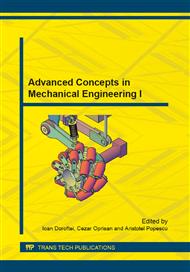p.173
p.177
p.183
p.189
p.195
p.201
p.207
p.213
p.219
The Influence of the Fatigue Cycles Number on Material Hardness
Abstract:
In this paper we present the experimental results obtained after determining hardness on samples previously subjected to fatigue. Firstly, 6 identical samples have been subjected to stress fatigue in the elastic range a number of 105, 5∙105, 106, 2∙106, 3∙106 and 4∙106 cycles. For all samples we used the same form of stress cycle, respectively, sinusoidal, and the same values of maximum, minimum force and the amplitude of the cycle (50 kN, 30 kN and 10 kN). It is noted that the maximum value of the load was less than that at which samples fall within the plastic deformation. Therefore, the original loading of samples was performed in the elastic range. For each of the six samples determinations of levels of hardness were performed, with the value of indentation load of 10 kgf. Indentations were made on the samples, along the length of the calibration, at a distance of 10 mm one within the other. As it will be seen below, in the areas with the highest hardness were performed several indentations, in order to determine the highest hardness area, which, in our view, also presents the largest degree of plastic deformation.
Info:
Periodical:
Pages:
195-200
Citation:
Online since:
October 2014
Authors:
Keywords:
Price:
Сopyright:
© 2014 Trans Tech Publications Ltd. All Rights Reserved
Share:
Citation:


